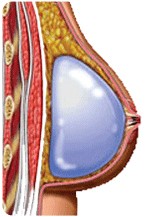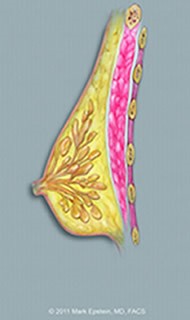Breast Augmentation
As leaders in the field of cosmetic surgery, our ABCS surgeons are not only skilled in the most effective, state-of-the-art surgical techniques—they helped pioneer them. Learn about the latest in breast augmentation below.
What Is Breast Augmentation Surgery?
Breast augmentation is a cosmetic surgery procedure to increase breast size and enhance breast shape, typically through the placement of silicone or saline breast implants. From a cosmetic surgeon’s perspective, the ultimate goal of breast augmentation is to enhance a patient’s natural proportions and create a more symmetrical, aesthetically pleasing breast profile. The exact procedure is tailored to meet a woman’s individual needs.
There is no “typical” breast augmentation patient, and women choose to have the procedure for many different reasons—having larger breasts is just one of them. Breast augmentation is one of the most effective procedures to correct noticeable breast asymmetry, and breast implants can be used to help correct tuberous breast deformities. Other common goals of breast augmentation:
- Restoring breast fullness lost after pregnancy & breastfeeding
- Feeling more confident in a swimsuit
- Adding balance to better complement curvy hips
- Enhancing self-image
Breast Implant Choices
There’s never been a better time to have breast augmentation, as today you have more choices than ever to help you customize your new look. Whether you’d like more dramatic curves or a modest boost in cleavage, there’s an option for you. Here are some choices you can expect to go over during your consultation process:
- Filling type: Silicone Gel, Implants.. Your cosmetic surgeon will help you find the right implant type for you.
- Shape: Silicone Gel implants are typically round, while Round implants will typically achieve a fuller upper pole (the top portion of your breast
- Profile: Your cosmetic surgeon will help you choose this based on your existing proportions and your goals. Generally, patients with a more petite frame will require a higher profile implant to achieve the desired size increase while ensuring the implants are not too wide at the base.
- Size: Breast implants range in size from about 150cc to 800cc or larger. Many patients require a different sized breast implant for each breast; this helps to achieve the best possible symmetry. The size you choose depends on your existing breast size, your personal goals, and your cosmetic surgeon’s recommendations.
Of course, all of these options make it even more important to choose a cosmetic surgeon who is well-qualified and has experience using a variety of breast implants.
Incision Options for Breast Augmentation
One common question that patients have before breast augmentation is, “What will my scars look like?” You’ll be glad to learn that an experienced, qualified cosmetic surgeon will use a surgical technique that places breast augmentation incisions so the resulting scars are easily hidden and inconspicuous, even to the patient herself. Depending on your anatomy and your desired outcome, your cosmetic surgeon will use one of the following incision techniques to place your breast implants:
Breast Implants Over the Muscle

Subglandular placement means that the breast implant is placed just behind the breast tissue.
Advantages of Subglandular Breast Implant Placement
Placing the breast implants above the muscle is a pretty easy and straightforward surgery.
One advantage of getting breast implants over the muscle is a shorter recovery time. Since the muscle does not need to be dissected in any way, recovery is much easier, not to mention quicker.
Women wanting breast implants that are too large to fit underneath the muscle may find that having them placed above the muscle will allow them to get the size they want. Over the muscle placement allows for larger implants (to a degree).
In cases where ptosis (sag) is an issue, placement over the muscle may alleviate the need for a lift, thus resulting in less expense and recovery. However, if ptosis is an issue, the avoidance of a lift will only be temporary, as you will likely need one at some point in the future.
- Inframammary. This involves a short incision made in the crease underneath the breast, called the inframammary fold. This leaves a thin, 1 to 2 inch scar that is easily concealed within the crease. Advantages of this incision type include a wider access point, allowing a cosmetic surgeon to place larger silicone implants or gummy bear implants with precision.
Life After Breast Augmentation
Breast augmentation is an outpatient procedure, typically performed using general anesthesia. You can expect to walk around on your own a few hours after surgery, and most patients feel up to leaving the house within the next day or two.
You may feel sore the first week or so, and you will need to limit strenuous exercise for about 2-4 weeks. Your cosmetic surgeon may also ask you to wear a supportive surgical bra or sports bra for a certain period of time after breast augmentation—it is crucial to follow your cosmetic surgeon’s instructions to ensure you heal optimally.
Once you have your breast implants, you’ll want to keep the following in mind:
- It’s safe to have mammograms with breast implants, so be sure to maintain regular screening as prescribed by your doctor.
- For silicone implants, it is recommended that patients undergo periodic monitoring (via mammogram, ultrasound or MRI) to screen for ruptures, which are rare.
- Future pregnancies or weight fluctuations may affect your results, and a secondary surgery may be needed to correct any changes you are unhappy with over time.
- Nothing can stop the normal aging process; over time, breast tissue will change. You can help prevent unnecessary sagging by wearing a bra with adequate support for your activity level.
When performed by a qualified cosmetic surgeon, breast augmentation is a safe surgery with long-lasting results, and the overwhelming number of patients are very glad they chose to have the procedure. The best way to decide whether or not breast augmentation is right for you is to meet with Dr. van der Walt, your cosmetic surgeon for a consultation.


Anatomy of the breast, pectoralis major muscle and chest wall (ribs) – LAT ©2011 Mark Epstein, MD, FACS
The layers of the breast and chest wall are as follows: breast lies on top of the pectoralis fascia which lies on top of the pectoralis major muscle (the “pecs”) which lies on top of the chest wall (rib cage and rib muscles). The pectoralis muscle is a triangular shaped muscle that has a broad attachment along the sternum (breast bone) and the medial (inner) side of the ribs near the sternum, then spans across the chest to attach on the humerus (upper arm bone). Implants are put between the breast and the underlying muscle fascia (subglandular or “above the muscle”)
